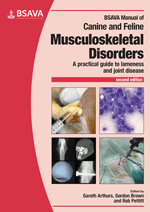
Full text loading...

Conditions affecting the hip, or coxofemoral joint, are common in small animal practice, especially in younger animals where a variety of developmental conditions can be encountered. This chapter covers the clinical anatomy, clinical examination, diagnostic investigations, and management of a range of conditions affecting the hip. Includes Quick Reference Guide to Imaging Techniques by Thomas W. Maddox. Operative Techniques: Craniolateral approach to the hip; Dorsal approach to the hip; Ventral approach to the hip; Hip toggle; Iliofemoral suture; Transarticular pin; Dorsal capsular sling; Femoral head and neck excision.
The hip, Page 1 of 1
< Previous page | Next page > /docserver/preview/fulltext/10.22233/9781910443286/9781910443286.22-1.gif

Full text loading...









































